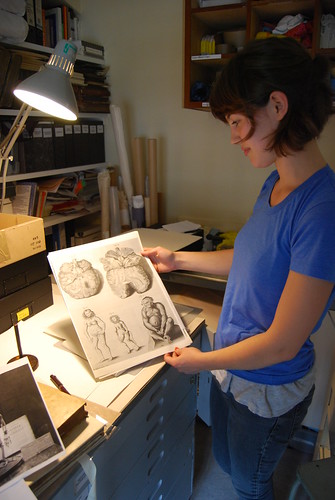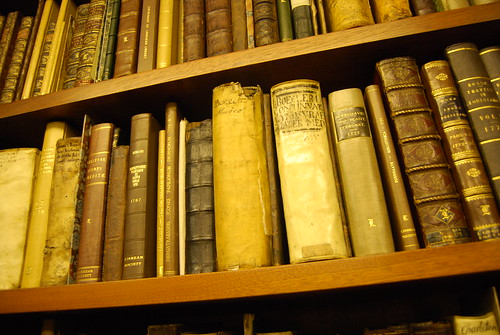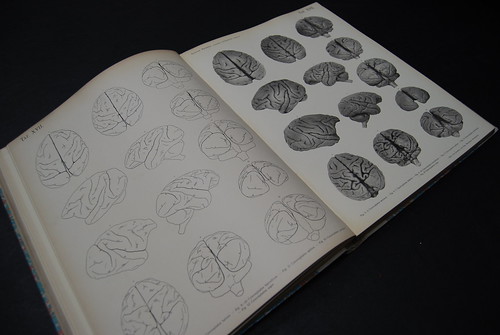The past few days have been rather hectic, hence the lack of updates. On Saturday, I attended and took part in Europe's first science blogging conference, and there were also several other events which had been organized for those who came to the event from abroad.
Last Thursday evening, I was forced to go on a scientific pub crawl, and on Friday I joined a group of about 20 others for a London science tour. Both events were organized and led by Matt Brown, who pretended that it was part of his job rather than an excuse for him to indulge in his hobbies and show off his extensive knowledge of London's places of scientific interest and the city's history.
The science tour began at around 10.30 on the Friday morning. After meeting outside the Macmillan Building near King's Cross, we were shown around the Nature offices by Maxine Clarke, where I took the above photograph of an editor at work on the cover design for the forthcoming issue of the journal.

We then walked down to the Euston Road and then walked west to see the Wellcome Collection. There, we looked around the Skeletons exhibition before heading upstairs for Medicine Now (above) and - my favourite - Medicine Man, which contains, among other things, antique prosthetic limbs and surgical instruments and a few of the many artifacts collected by Henry Wellcome during his travels around the world.
After having lunch at the Russell Square Cafe, we took the underground to Piccadilly Circus and walked the short distance to the Linnean Society. Librarian and archivist Gina Douglas took us into the meeting room where Darwin and Wallace read their papers on evolution papers on July 1st, 1858, and then down a narrow flight of steps to the collection room. This room, which measures approximately 15 feet square and is hidden behind a 6-inch metal door, contains Linneas's own books, including a first edition of his classification system, as well as some 14,000 plant and 3,200 insect specimens.
Back upstairs in the library, Martin Fenner pointed out a very beautiful late-nineteenth century textbook of comparative neuroanatomy by the Swedish physician Anders Retzius (and then took a photograph of me admiring it). As the others made their way out, the conservator kindly took me upstairs, so that I could get a photo of the library from higher up, and then, unexpectedly, into a room at the back...

...where a colleague of hers was restoring a late-17th century anatomy text which includes descriptions of pygmys' brains. I caught up with the others and together we went around the corner to the Geological Society to take a quick look at "the map that changed the world".
Finally, we made our way to the Natural History Museum in South Kensington. There, we met Karen James of the HMS Beagle Project, who took us into the Darwin Centre's tank room, an extraordinary place full of animal specimens preserved in enormous jars and metal tanks, which also contains several dozen specimens collected by Darwin himself during his time on the Beagle.
Update: The book in the penultimate photograph is The Anatomy of a Pygmie by Edward Tyson, first published in 1699.




Wow, have very exciting to be able to experience such important pieces of scientific history.
Comparative neuroanatomy drawings are always so mesmerizing.
I remember the first time I held a whale brain, it was AWEsome.
Poor Mo. Waves of transatlantic sympathy for the endurance and dedication required for the pursuit of the scientific life. The textbook admiration shot clearly shows how much you were suffering for your art. For the transatlantic envy, we can trust your imagination to run free.
Getting paid to restore old books - there's some solace to counterbalance the ugliness of the daily grind.
I am so painfully jealous of the things you saw! Initially, I thought I would be able to go, but as the date grew closer, meetings and conference thingies got in the way. Shame. I am grateful for the narrative and great pictures though! Can't imagine the ridiculous fan-boy trip I would go on upon seeing Darwin's own hand-writing on sample jars. Unbelievable!
It was a shame I couldn't make thatI was giving a seminar at my old place in Cambridge. Sounds like it was fun.
It was good to meet you, though Mo. Now, I think I'm over my jetlag...
Good to meet you to Richard, albeit so briefly. You too Anna.